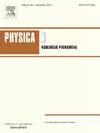Walking dynamics of a bipedal robot with impulsive actuation
IF 2.7
3区 数学
Q1 MATHEMATICS, APPLIED
引用次数: 0
Abstract
Impulsive actuation, which includes hip joint pulse torque and heel pulse thrust, is introduced to build a walking model of a bipedal robot on level ground in this study. The impulsive actuation configuration and the mechanism of stable walking motion are investigated. The existence and stability of period and 2 gaits are investigated by means of the discrete map. The conditions for flip bifurcation and inverse flip bifurcation of period gait are derived. The complex walking dynamics, such as period gait, flip bifurcation and inverse flip bifurcation of period gait, and chaotic gait, are obtained by numerical simulations. By using period gait, theoretical analysis is conducted on the energy consumption of applying pulse torque and constant torque to the hip joint under the same conditions. Numerical results show that the energy consumption of pulse torque is less than that of constant torque. The superiority and walking dynamics caused by impulsive actuation can provide theoretical reference for designing bipedal robots with stable and efficient walking.
脉冲驱动双足机器人的行走动力学
本研究引入了包括髋关节脉冲力矩和足跟脉冲推力在内的脉冲驱动,建立了两足机器人在平地上行走的模型。研究了脉冲驱动结构和稳定行走运动的机理。利用离散映射研究了周期- 1和周期- 2步态的存在性和稳定性。推导了周期- 1步态翻转分岔和逆翻转分岔的条件。通过数值仿真,得到了周期为- 4的步态、周期为- n(n=2,4)的步态翻转分岔和逆翻转分岔以及混沌步态的复杂行走动力学。采用周期- 1步态,对相同条件下对髋关节施加脉冲转矩和恒转矩的能量消耗进行理论分析。数值结果表明,脉冲转矩的能量消耗小于恒转矩的能量消耗。脉冲驱动的优越性及其产生的行走动力学特性可为设计稳定、高效行走的双足机器人提供理论参考。
本文章由计算机程序翻译,如有差异,请以英文原文为准。
求助全文
约1分钟内获得全文
求助全文
来源期刊

Physica D: Nonlinear Phenomena
物理-物理:数学物理
CiteScore
7.30
自引率
7.50%
发文量
213
审稿时长
65 days
期刊介绍:
Physica D (Nonlinear Phenomena) publishes research and review articles reporting on experimental and theoretical works, techniques and ideas that advance the understanding of nonlinear phenomena. Topics encompass wave motion in physical, chemical and biological systems; physical or biological phenomena governed by nonlinear field equations, including hydrodynamics and turbulence; pattern formation and cooperative phenomena; instability, bifurcations, chaos, and space-time disorder; integrable/Hamiltonian systems; asymptotic analysis and, more generally, mathematical methods for nonlinear systems.
 求助内容:
求助内容: 应助结果提醒方式:
应助结果提醒方式:


